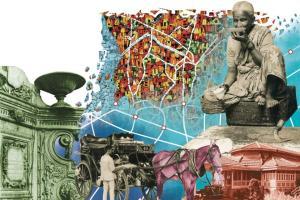Meher Marfatia's new book Once Upon A City celebrates carbon-dating in Mumbai as never before.

Illustration/Uday Mohite
 I've known author and fellow Sunday mid-day columnist Meher Marfatia since the early 1980s. Sure, that’s carbon-dating us. But her new book Once Upon A City celebrates carbon-dating in Mumbai as never before. And, fellow columnist Rahul daCunha has been a solid supporter of the book. The column has been wildly popular Now its juiciest morsels have been condensed into a plump, but handy-sized book. Its tag-line: making the little stories of Mumbai matter.
I've known author and fellow Sunday mid-day columnist Meher Marfatia since the early 1980s. Sure, that’s carbon-dating us. But her new book Once Upon A City celebrates carbon-dating in Mumbai as never before. And, fellow columnist Rahul daCunha has been a solid supporter of the book. The column has been wildly popular Now its juiciest morsels have been condensed into a plump, but handy-sized book. Its tag-line: making the little stories of Mumbai matter.
ADVERTISEMENT
Apart from her legion fans, Meher’s reveals that her biggest compliment came from a little old lady with failing vision, whose doctor had forbidden her to read: “‘I told him to make one exception every other Sunday, when Once Upon A City appears, because I really enjoy it,’ she told me. Touched, I thanked her and apologised that it’s a longish column. ‘No, no, don’t you shorten it by a single word, dear,’ she replied.”
Although the book is about Mumbai’s history, it is written in delightful, bite-sized morsels in Meher’s inimitable style, jammed with photos—old black and white photos, alongside recent, colour photos, with area maps, locality-wise listing, and all. It’s a terrific gift for families, sundered by individual mobile phones, to unite over squealy, nostalgic sessions. Likewise, for sundered families and sworn enemies. Meher wears the city’s formidable history light as a thistle. She quotes noted historians Sharada Dwivedi and Rahul Mehrotra, but is equally pleased to have an umbrella repairer be her local gully guide. After wading through tons of tomes, maps and photographs, and doing dozens of interviews, she distils Mumbai’s history to read like delicious gupshup with a friend. The book makes us keenly aware of the incredible riches and sheer diversity of ordinary people’s history—apart from the rich legacy of architecture, not to mention trees and birds. The book recalls that the city has nurtured Zubin Mehta, Pu La Deshpande, Bhishtis who distribute water carried in mashaqs, surmawalla Mohammad Anis, historian Foy Nissen and Raj Kapoor, who celebrated the 1964 premiere of Sangam at Apsara (with photo). That’s Ranbir Kapoor’s granddad for GenNext. And Manmohan Desai, who enjoyed gully cricket, and said, “My level is the ground. I can’t make movies from the 36th floor.” That’s why his movies will outlast any political party who cons you into believing that Mumbai is for anyone other than Amar Akbar Anthony.
Above all, the book is a clarion call to Mumbaikars to acknowledge and reclaim our rich, multiple, national and international identities. The city is home to communities and the descendants of Maharashtrians, East Indians, South Indians, Punjabis, Bohris, Sindhis, Parsis, Catholics, Jews, Afghans, Persians, Arabs, British, the Portuguese and many more. Most of us have enjoyed a Maharashtrian misal or vada pao. Been bowled out at cricket by a Bawa. Danced at the wedding of a Christian neighbour. Had a Muslim friend drop our sister home safely after tuitions. Had a Gujarati CA smartly save our tax. Had a Tamilian friend discreetly provide a school scholarship. Showed off a gorgeous Jewish synagogue to foreigners. Or variations thereof. If you took all these people out of the city, is there anything left to Mumbai? Or Mumbaikars? Toh khalipili bomabom kaiku kartai?
Meenakshi Shedde is India and South Asia Delegate to the Berlin International Film Festival, National Award-winning critic, curator to festivals worldwide and journalist.
Reach her at meenakshi.shedde@mid-day.com
Catch up on all the latest Crime, National, International and Hatke news here. Also download the new mid-day Android and iOS apps to get latest updates
 Subscribe today by clicking the link and stay updated with the latest news!" Click here!
Subscribe today by clicking the link and stay updated with the latest news!" Click here!






